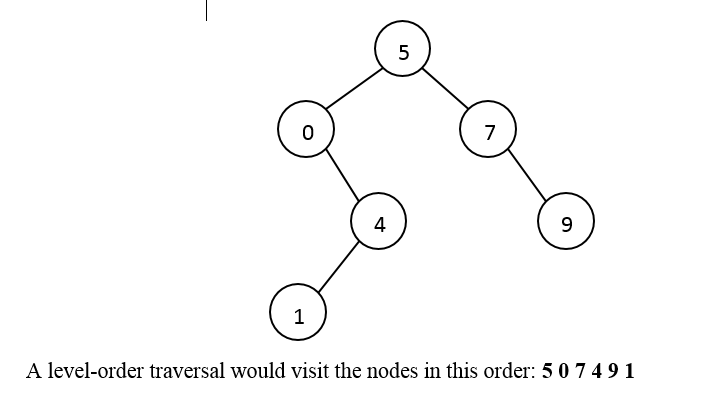Question
(1) ) For these following coding problems, use the BinarySearchTree class that we used in lecture (code as a starting point. (See attachment files in
(1))For these following coding problems, use the BinarySearchTree class that we used in lecture (code as a starting point. (See attachment files in eLearn assignment 9)
Write a method findHeight() that returns the height of the calling tree. Remember that the height is the maximum level of the tree, with level 1 being the root. (Hint: A recursive solution is nice and short.)
In class we discussed pre-order, in-order, and post-order traversals. Another common type of tree traversal is a level-order traversal. This involves visiting the nodes of the tree left-to-right, top-to-bottom (just like the way you normally read a page of text). For example, consider the BST below:

Write a levelOrderTraversal method. The method should print the nodes in the order that they are visited. (Hint: one non-recursive algorithm for this is to use a queue to keep track of the nodes that you want to visit. Start by enqueuing the root node, and see what needs to be done from there.)
files in eLearn assignment 9:
import java.util.Iterator;
import java.util.LinkedList;
import java.util.Queue;
import java.util.Stack;
/*
* This class implements a binary search tree.
*/
// The
// must be from a class that implements the Comparable interface (i.e., provides
// a definition for the compareTo method).
//
// Any class that provides an iterator() method can implement the Iterable
// interface. This allows us to use the enhanced for syntax with objects of this class.
public class BinarySearchTree
// This nested class implements an in-order iterator over the elements of this BST
// (i.e., the elements are returned in the same order as an in-order traversal).
private class InOrderIterator implements Iterator
private Node
private Stack
@Override
public boolean hasNext() {
return !(current == null && pile.empty());
}
@Override
public E next() {
while (current != null) {
pile.push(current);
current = current.left;
}
Node
current = popped.right;
return popped.data;
}
}
// This nested Node class is very similar to the one we used for
// LinkedList. But, tree nodes must keep track of both left
// and right children, instead of just one next node.
private static class Node
private E data;
private Node
// Constructor
public Node(E data, Node
this.data = data;
this.left = left;
this.right = right;
}
}
private Node
/****** BEGIN HW 8 METHODS ******/
/****** All remaining methods were provided in lecture ******/
// Returns an in-order iterator over the elements of this BST.
public Iterator
return new InOrderIterator();
}
// Wrapper method for preOrderTraversal
public void preOrderTraversal() {
System.out.println("Doing a pre-order traversal");
preOrderTraversal(root);
}
// Performs an pre-order traversal of the subtree rooted at where
private void preOrderTraversal(Node
if (where != null) {
System.out.println(where.data);
preOrderTraversal(where.left);
preOrderTraversal(where.right);
}
}
// Wrapper method for inOrderTraversal
public void inOrderTraversal() {
System.out.println("Doing a in-order traversal");
inOrderTraversal(root);
}
// Performs an in-order traversal of the subtree rooted at where
private void inOrderTraversal(Node
if (where != null) {
inOrderTraversal(where.left);
System.out.println(where.data);
inOrderTraversal(where.right);
}
}
// Wrapper method for postOrderTraversal
public void postOrderTraversal() {
System.out.println("Doing a post-order traversal");
postOrderTraversal(root);
}
// Performs a post-order traversal of the subtree rooted at where
private void postOrderTraversal(Node
if (where != null) {
postOrderTraversal(where.left);
postOrderTraversal(where.right);
System.out.println(where.data);
}
}
// Wrapper method for find
public E find(E dataToFind) {
return find(dataToFind, root);
}
// Recursively finds dataToFind in the subtree rooted at where.
// Returns the item from the tree if found, or null if not found.
private E find(E dataToFind, Node
if (where == null) // Empty subtree - dataToFind does not exist
return null;
else if (where.data.equals(dataToFind)) // dataToFind has been found
return where.data;
else {
// Determine whether to search the left or the right subtree
int compare = dataToFind.compareTo(where.data);
if (compare
return find(dataToFind, where.left);
else
return find(dataToFind, where.right);
}
}
// Wrapper method for add
public void add(E dataToAdd) {
root = add(dataToAdd, root);
}
// Recursively adds the dataToAdd to the subtree rooted at where.
// Returns a reference to where, with the dataToAdd already added.
private Node
if (where == null) // We've reached an empty spot in the tree - dataToAdd should be added here!
return new Node(dataToAdd, null, null);
else {
// Determine whether to add to the left or right subtree
int compare = dataToAdd.compareTo(where.data);
if (compare
where.left = add(dataToAdd, where.left);
else if (compare > 0)
where.right = add(dataToAdd, where.right);
// Do nothing if compare == 0 (i.e., if dataToAdd already exists in the tree)
return where;
}
}
// Wrapper method for delete
public void delete(E dataToDelete) {
root = delete(dataToDelete, root);
}
// Recursively deletes dataToDelete from the subtree rooted at where.
// Returns a reference to where, with the dataToDelete already deleted.
private Node
if (where == null) // Empty subtree - nothing to delete
return null;
else {
// Determine whether to search down the left or right subtree
int compare = dataToDelete.compareTo(where.data);
if (compare
where.left = delete(dataToDelete, where.left);
return where;
} else if (compare > 0) {
where.right = delete(dataToDelete, where.right);
return where;
} else { // where contains dataToDelete
if (where.left == null && where.right == null) // Case 1: where has no children
return null;
else if (where.left != null && where.right == null) // Case 2a: where has only a left child
return where.left;
else if (where.left == null && where.right != null) // Case 2b: where has only a right child
return where.right;
else { // Case 3: where has 2 children, OH NOES run for the hills
where.data = findAndDeleteIOP(where);
return where;
}
}
}
}
// Finds and deletes the in-order predecessor of the node where.
// Returns the value of the IOP that was removed.
private E findAndDeleteIOP(Node
// parent starts from where, temp starts from the root of where's left subtree
Node
// Move temp as far right as possible. When this loop exits,
// temp is pointing to where's in-order predecessor, and parent
// is pointing to the IOP's parent node.
while (temp.right != null) {
parent = temp;
temp = temp.right;
}
E toReturn = temp.data;
if (parent == where) // This means we have not moved down the tree at all - i.e., where's IOP is just where's left child
parent.left = temp.left;
else
parent.right = temp.left;
return toReturn;
}
// Wrapper method for toString (also overrides the toString inherited from Object)
public String toString() {
return toString(root, "");
}
// Recursively computes a toString of the subtree rooted at where.
// The indent parameter keeps track of how many spaces should be included in front.
private String toString(Node
if (where == null)
return indent + "null";
else
return indent + where.data + " " + toString(where.left, indent + " ") + " " + toString(where.right, indent + " ");
}
public static void main(String[] args) {
BinarySearchTree
Integer[] data = {5, 8, 9, 10, 3, 0, -2};
for (Integer i : data)
myTree.add(i);
Iterator
while (it.hasNext())
System.out.println(it.next());
// Since BST implements Iterable, it can use the enhanced for syntax
// (which does the same thing as the iterator loop above)
for (Integer i : myTree)
System.out.println(i);
}
}
0 4 1 A level-order traversal would visit the nodes in this order: 507491Step by Step Solution
There are 3 Steps involved in it
Step: 1

Get Instant Access to Expert-Tailored Solutions
See step-by-step solutions with expert insights and AI powered tools for academic success
Step: 2

Step: 3

Ace Your Homework with AI
Get the answers you need in no time with our AI-driven, step-by-step assistance
Get Started


